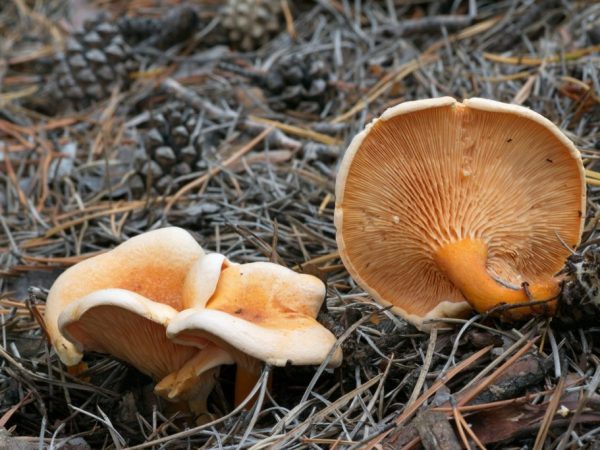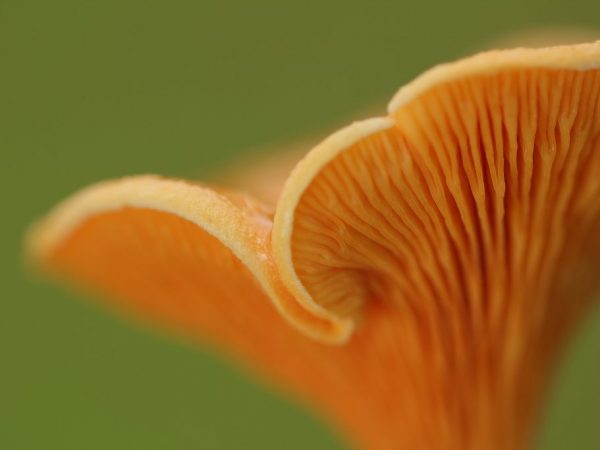Differences between common chanterelle and false mushroom
Inexperienced lovers of quiet hunting often find inedible mushrooms in the forests, counterparts of tasty and healthy varieties of fruit bodies. They are often poisonous and pose a serious health hazard. The false fox is no exception.

Differences between common chanterelle and false mushroom
The appearance of mushrooms
Real chanterelles are tasty and healthy, it is not for nothing that mushroom pickers constantly collect them, and cooks use them in the preparation of their masterpieces. This mushroom loves high humidity, grassy areas and moss. According to the description, it has, as it were, a solid body (its leg smoothly passes into the cap), it is distinguished by a bright color. The surface is bright: yellow or orange. When squeezed, the place of deformation turns red.
The hat resembles an inverted one, in shape it is similar to a flower bud. The edges are uneven, wavy. Its diameter often exceeds 12 cm. Chanterelles grow in a family of 5-20 mushrooms. They have a raw, fruity aroma.
Irina Selyutina (Biologist):
When collecting mushrooms, it is important to carefully consider the outside of the wrinkled chanterelle cap. It is these "folds" or, more precisely, pseudo-plates that indicate that this is indeed the same edible mushroom in front of you. Seeing them with your own eyes once will never be confused with other mushrooms. Unlike the plates, they have rounded edges and very smoothly transition to the leg, so it is difficult to determine the clear border between the leg and the cap in a real chanterelle.
The mushroom, which is popularly called the talker (false chanterelle), is distinguished by a small number of signs. It is conditionally edible. When properly prepared, the harm from the use of the product is absent or minimal.
Features of chanterelle twins
Outwardly, representatives of the present and false appearance are like doubles. Slight differences can be seen in the colors.
False and true chanterelles grow in mixed and coniferous forests, develop in moss and in open areas of land. Unlike its twin, a real mushroom does not grow at the roots of fallen trees.
If in doubt, it is best to refuse to collect suspicious mycelium.
Learning to identify false chanterelle mushrooms is easy. These nuances are taken into account:
- The edible mushroom is rarely brightly colored. Talkers are bright orange.
- Talkers have a smoother head shape than real edible fruiting bodies.
- The talker's leg is thinner than that of a real mushroom.
- When you press the flesh, a real member of the Cantarella family is left with a red spot. The talker is distinguished by the absence of such a feature.
- Inedible species rarely grow in large families.
- The spores of the edible fruiting body are yellow. The twins are white (this is a difference at the microscopic level, but in large quantities you can see the color of the spore powder).
Irina Selyutina (Biologist):
The surface of the cap of a young orange talker, or false chanterelle, is dry and thin velvety.On its orange or yellow-orange skin, barely noticeable rings can be seen (they disappear as the mushroom matures). The plates of the hymenophore (real plates, not folds) are often located, thick, larger than the pseudo-plates of the real chanterelle and differ sharply from them in appearance. There is a clear border between the leg and the cap. In their color, the plates are much brighter than the surface of the cap and turn brown when pressed on them. The leg is the same color with the plates and is also brighter than the cap. The base can be curved. In old mushrooms, it is hollow.
Having figured out how false chanterelles differ from real ones, it will be possible to significantly reduce the risk of error when harvesting mushrooms. Inedible chanterelles contain toxic substances.
Are the talkers edible
Unlike their edible counterpart, talkers eat much less often. They are conditionally edible. But the false chanterelle still often ends up in the baskets of inexperienced mushroom pickers or those who know the secrets of its preparation.

It is important to prepare the talkers correctly
Talkers will not harm a person if prepared correctly. Pay attention to pre-processing:
- Fruit bodies are washed under running water.
- Mushrooms are poured with water for 3 days, changing it 2 times a day.
- The fruit bodies are boiled in water with onions for 20 minutes.
All poisons and heavy metals disappear during cooking - they go into the broth and the product becomes harmless. Having protected himself from the signs of poisoning, a person gets less attractive-looking mushrooms. The structure of the flesh and flavor characteristics also change.
The consequences of eating talkers
If the preparation of the talkers does not include preliminary heat treatment, there is a high risk of getting poisoned. Symptoms appear within 1-2 hours after ingestion of the product.
Talkers negatively affect the physical health and mental state of a person:
- There are problems with the gastrointestinal tract: possible nausea, vomiting, abdominal pain, diarrhea.
- General deterioration in well-being: there is a feeling of weakness, fever, chills.
- Insanity and hallucinations: toxic substances contained in the product often lead to irreversible changes in the mental state. They can be irreversible.
With chronic diseases of the gastrointestinal tract, heart, kidneys and liver, lethal cases from the use of talkers are possible. If, after eating mushrooms, one or more signs of poisoning were detected, you should not delay calling an ambulance. After calling an ambulance, it is worth providing the victim with first aid.
Conclusion
False chanterelles are conditionally edible mushrooms. They have some differences in color and shape of the fruit body. When properly prepared, the risk of poisoning is minimal. You can distinguish false chanterelles by some external signs. It is important to collect only those fruiting bodies in the quality and external features of which a person is confident.



